
Muscat: People in Muscat and many other parts of the country are feeling the heat because of one reason: it is summertime.
This year, however, summer is significantly hotter because of warm, dry winds blowing towards the northern regions of Oman from the Empty Quarter to the southwest.
These winds pass over elevated mountain areas and down into flatter locations, making them considerably warmer.
“Well, the natural answer is that it is now summertime,” said a forecaster at the Department of Meteorology at the Civil Aviation Authority.
“But this year is hotter and drier because of the desert winds from the Rub Al Khali. When these winds blow up and then down the slopes of mountains, a warm and dry wind called Foehn’s Wind is created.”
“Because Muscat is primarily surrounded by mountains, people in the capital will be feeling this effect more,” he added.
“This is particularly true in areas like Amerat and Seeb.”
Unlike the north, Oman’s south is currently experiencing far better weather, because of the monsoon winds that are blowing in from the Indian Ocean, heralding the start of the Khareef season.
In the Dhofar region, and its capital Salalah, the Khareef season is characterised by continual rainfall, cool breezes and refreshing mists, all of which also work to turn the surrounding lands green with vegetation.
“In the south, it is now about 15 degrees cooler than it is in Muscat and other surrounding areas,” explained the weather official.
The intense heat felt during the day often carries on into the night as well, reducing the effectiveness of air conditioners that many have switched on to keep the high temperatures at bay.
“The hot winds in Muscat are expected to end around July 15, after which they will be replaced by cooler winds coming in from the northeast – the Arabian Sea and the Sea of Oman,” explained the forecaster.
“Temperatures will still be high, but the ACs will work better at cooling, because the air will be moister, with a humidity of about 60 to 70 per cent.”
He added that hot weather of this nature is felt every summer, and that the heat will begin to subside in August.
In Muscat, Seeb on July 4, Seeb recorded temperatures of 36 degrees, while Amerat was significantly hotter at 43 degrees.
Buraimi on the border with the United Arab Emirates was the hottest place in the country at 47 degrees, Ibri, Adam, and Fahud saw temperatures of 46 degrees, as did Marmul in the south.
Sur, Samail, and Haima (45 degrees), Nizwa, Bahla, Rustaq, and Al Mudheibi (44 degrees), and Khasab, the capital of the northern governorate of Musandam, at 41 degrees, all recorded high temperatures.
Conversely, Salalah in the south had a maximum of 30 degrees, while Jabal Samhan, up in the mountains of the Dhofar, was five degrees cooler.